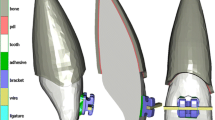Abstract
Material and Method: The force system delivered by the rectangular loop (R-loop) was the subject of this in-vitro investigation. The correction of a first-order irregularity was simulated in an inconsistent force system. Three types of R-loop made of 0.017"×0.025" TMA wire but differing in length and insertion system were tested in a 3D strain gauge (Hottinger™, Darmstadt, Germany). The buccal segment consisted of one molar and two bicuspids, with the first bicuspid as an active unit scheduled to be moved buccally into the dental arch.
Results: The first R-loop tested revealed too high a force magnitude to be recommended for clinical use. A loop connecting only two teeth and bypassing the second premolar delivered a favorable initial force of 85 cN with a drop of 20 cN per 1 mm deactivation. In order to achieve a translatory tooth movement, a buccal root torque must be bent in addition into the short horizontal leg of the R-loop. The use of a transpalatal arch is indispensable if adverse side effects are to be avoided.
Zusammenfassung
Material und Methode: In einer In-vitro-Untersuchung wurde das Kraftsystem der R-Feder gemessen. Simuliert wurde die Korrektur von Fehlstellungen erster Ordnung. Die Prüfsituation entsprach einem inkonsistenten Kraftsystem. Drei in Drahtlänge und Art des Eingliederns sich unterscheidende R-Federn aus 0,017"×0,025"-TMA-Draht wurden in einer 3-D-Messapparatur (Fa. Hottinger™, Darmstadt) getestet. Das bukkale Segment bestand aus einem Molaren und zwei Prämolaren, wobei der erste Prämolar als aktive Einheit nach bukkal in den Zahnbogen bewegt werden sollte.
Ergebnisse: Es zeigte sich, dass die als erste getestete R-Feder wegen ihrer zu großen Kraftabgabe nicht zum klinischen Einsatz gebracht werden kann. Günstig erwies sich die Feder, die unter Umgehung des zweiten Prämolaren, einer Zwei-Zahn-Beziehung entsprechend, den ersten Prämolaren und Molaren verband. Die nach bukkal gerichtete Kraft betrug dabei 85 cN mit einem Kraftabfall von 20 cN pro 1 mm Deaktivierung. Um eine translatorische Bewegung erzeugen zu können, muss zusätzlich ein bukkaler Wurzeltorque im kurzen horizontalen Schenkel der R-Feder eingebogen werden. Zur Vermeidung unerwünschter Nebenwirkungen ist die Verwendung eines Transpalatinalbogens unerlässlich.
Similar content being viewed by others
Author information
Authors and Affiliations
Additional information
Received: January 10, 2001; accepted: December 6, 2001
Rights and permissions
About this article
Cite this article
Crismani, A., Freudenthaler, J., Bernhart, T. et al. Rectangular Loops in Inconsistent Force Systems: A Laboratory Investigation. Journal of Orofacial Orthopedics / Fortschritte der Kieferorthopädie 63, 105–112 (2002). https://doi.org/10.1007/s00056-002-0102-9
Published:
Issue Date:
DOI: https://doi.org/10.1007/s00056-002-0102-9




